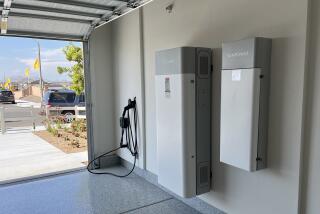Whole-House Generators Can Keep Electricity Flowing
Question: There are occasional electrical power outages in my area, so I thought about getting an automatic whole-house emergency generator. Are they expensive to operate and can they really power an entire house?
Answer: Whole-house standby generators are becoming much more popular because of the many electrical devices used in homes today. It can often be difficult for a family to get by without electricity for even a short time.
If you are away from home and your lights and security system don’t function because of a power outage, your house is easy prey for thieves or vandals.
Although you can install a manual transfer switch to switch over to the standby generator, most whole-house standby generators use an automatic transfer switch. When the electricity goes off, it automatically disconnects your house from the power grid and starts the generator.
Most models restore full electric power to your house in about 10 seconds. About all you will have to do is reset your digital clocks. The automatic transfer switch also “exercises” the motor and generator every week or two to make sure it is in good working condition when needed.
For most homes, a 10-kilowatt to 15-kilowatt output standby generator will provide adequate power. Most models in this residential-size range are powered by natural gas or propane and are relatively efficient and inexpensive to operate. Models with diesel engines are also available.
Models that run on natural gas or propane have a small one- or two-cylinder engine inside. Running on these very clean-burning fuels requires very little maintenance other than a spark plug or oil change every 100 or so hours of operation. The propane models are slightly more powerful.
Most standby generators are about the size of a typical central air-conditioner outdoor unit and are located near a house wall. The small gas or propane engines operate very quietly. The automatic transfer switch is usually located on the wall near your circuit breaker panel indoors.
A less expensive emergency generator option is a portable gasoline-powered model. Some of them have outputs as high as 6 kilowatts, so they can easily power most of your family’s essential needs. These normally use a manual transfer switch, so you must start the engine and throw the switch yourself.
With small portable generators, appliances are often plugged into the generator with extension cords. If any generator is attached to the house wiring, a transfer switch is needed to protect the utility company’s workers.
For more information, visit www.dulley.com to download Update Bulletin No. 605, a buyer’s guide to eight automatic whole-house and portable emergency generator manufacturers.
*
The Best Ways to Solve Cold-Shower Syndrome
Q: We run out of water for morning showers. Our incoming water is very cold, so I thought of installing a tankless water heater to preheat the incoming water to the main water heater. Does this sound good?
A: What you are suggesting would probably work, but it is not the best or most energy-efficient way to go. If your existing water heater is old, you might just consider replacing it with a new, higher-output model.
If family members can take showers consecutively instead of concurrently in several bathrooms, using a tank-less water heater to supply hot water directly for the bathrooms would be your best and most efficient option.
*
How to Match Tracks to Triple-Panel Doors
Q: I have a triple-track storm/screen door over my back door. I pulled out the glass and screen panels to clean them. How can I tell what is the proper way to position them back in the tracks?
A: Not all triple-track storm doors are the same, but in general, you can match up the panels with the width of the tracks. The track on the outdoor side is usually the smallest and the indoor one is the widest. The latches usually go to the bottom.
Also check the positioning of the weatherstripping between the panels. When installed properly in the door frame, the weatherstripping should seal all gaps between the panels.
*
Take an online tour of James Dulley’s house and see the money-saving improvements and products that he tests. There are nearly 100 pictures with links to the various columns that describe the improvements and products at www.dulley.com/house/.
More to Read
Sign up for Essential California
The most important California stories and recommendations in your inbox every morning.
You may occasionally receive promotional content from the Los Angeles Times.








